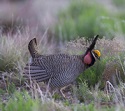 The lesser prairie-chicken had an iconic presence in the plains of southeastern New Mexico. Each spring, visitors from around the world would flock to the heart of lesser prairie-chicken country to participate in the annual High Plains Prairie-Chicken Festival in Milnesand, New Mexico. The entire community fed, housed, and entertained guests, who would get up before dawn to watch amorous male chickens strut and boom as the sun came up over the eastern plains. Unfortunately this festival has not been scheduled for several years because the prairie-chicken population dropped to levels that no longer sustained recreational viewing. In fact, the population of lesser prairie-chickens in New Mexico fell from an estimated 9,443 birds in 2008 to only 637 in 2014. The dramatic decline was primarily driven by extreme drought that was so severe in some areas that the shinnery oak did not leaf out and the normal mixed grasses could not be found. In parts of Roosevelt and Chaves counties, conditions were even worse than those recorded during the infamous Dust Bowl.
The lesser prairie-chicken had an iconic presence in the plains of southeastern New Mexico. Each spring, visitors from around the world would flock to the heart of lesser prairie-chicken country to participate in the annual High Plains Prairie-Chicken Festival in Milnesand, New Mexico. The entire community fed, housed, and entertained guests, who would get up before dawn to watch amorous male chickens strut and boom as the sun came up over the eastern plains. Unfortunately this festival has not been scheduled for several years because the prairie-chicken population dropped to levels that no longer sustained recreational viewing. In fact, the population of lesser prairie-chickens in New Mexico fell from an estimated 9,443 birds in 2008 to only 637 in 2014. The dramatic decline was primarily driven by extreme drought that was so severe in some areas that the shinnery oak did not leaf out and the normal mixed grasses could not be found. In parts of Roosevelt and Chaves counties, conditions were even worse than those recorded during the infamous Dust Bowl.
Numerous programs have been developed to provide quality habitat for the species at a landscape level scale. In New Mexico, there are Candidate Conservation Agreements in place for both the prairie-chicken and the dunes sagebrush lizard that are implemented on state, federal, and private lands. These agreements are focused on habitat conservation, restoration, and education to inform landowners and industry of the species needs and potential solutions. The Western Association of Fish and Wildlife Agencies, along with the New Mexico Department of Game and Fish implement a range-wide plan for the lesser-prairie chicken, focused on avoiding and mitigating habitat loss and restoring habitat with the goal of recovery for this species. These programs are working hard to protect suitable and occupied habitat, as well as increase potential habitat into the future.
 |
|
| Female lesser-prairie chicken landing. USFWS |
The lesser prairie-chicken, like other grouse species, is sensitive to changes in habitat, particularly vertical structures that may be considered predator perches. Additionally, encroachment into prairie-chicken habitat by woody vegetation, such as mesquite and elm, causes the bird to avoid the areas and leave these unique grassland habitats quite fragmented. Effective removal of this woody vegetation in the native mixed grass prairie is often expensive and time consuming. Historically, these areas were subject to periodic fires that kept encroachment of woody vegetation into the native grassland to a minimum. With the coordination of researchers, landowners, the US Fish and Wildlife Service and many others, stakeholders are now considering using fire as a restoration tool in the sand-shinnery ecosystem. Fire is often an alarming topic for landowners, due to the potential for unwanted spread and fear that precipitation might not return to assist in the regrowth of grass. However, when used correctly, prescribed fire can provide great benefits to native grassland communities by controlling encroaching woody vegetation, reducing invasive species, reinvigorating grassland and returning nutrients to the soil.
Along with the habitat restoration efforts, Mother Nature provided a much needed boost to the Southern Great Plains over the last year. In late 2014, and throughout 2015, New Mexico has received a welcome reprieve from drought with significant winter snow and continued precipitation this past spring and summer. This rain resulted in increased prairie-chickens found during routine roadside surveys, with an estimated population in New Mexico of 1,125 birds. Though the increase is minimal, compared to the overall decline, it is good news for those who love to see and hear these birds on the landscape. It is my hope, that with continued precipitation, unique partnerships, and habitat restoration, people will return to Milnesand, New Mexico for a festival unlike others, a festival celebrating the rebound of this unique grassland bird.
Debra Hill, Fish and Wildlife Biologist at the New Mexico Ecological Services Field Office, can be reached at Debra_Hill@fws.gov
